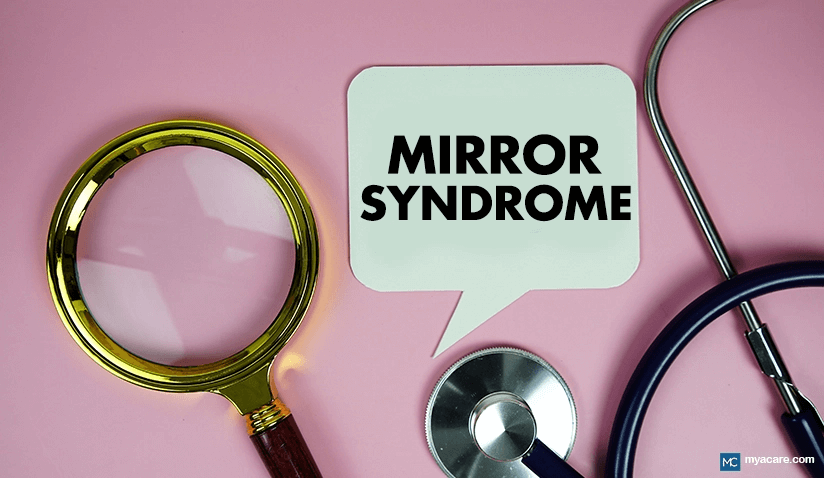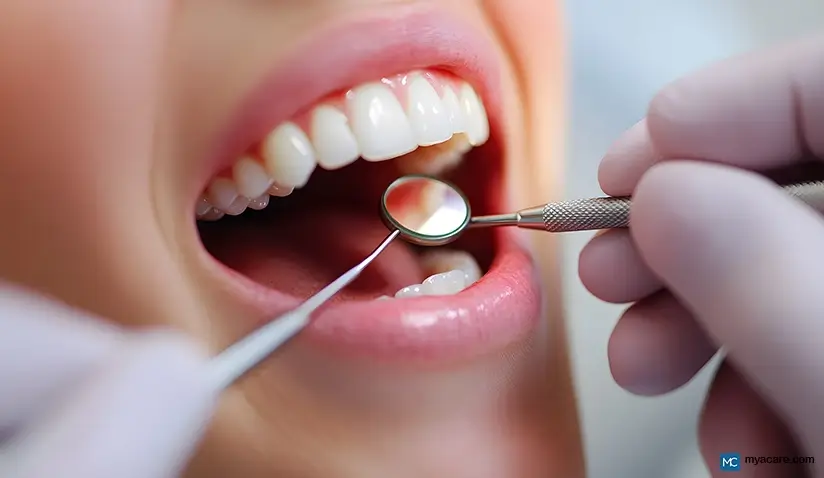Mirror Syndrome: Causes, Symptoms, and Diagnosis, Treatment and More

Medically Reviewed by Dr. Rae Osborn, Ph.D.
Mirror syndrome, also known as Ballantyne syndrome or triple edema[1], is a rare condition that affects pregnant women. It is characteristic of the development of edema (swelling) in the mother, which mirrors the edema seen in the fetus[2]. This syndrome can lead to serious complications for both the mother and the fetus, making early diagnosis and treatment crucial.
The condition has an estimated prevalence of 1 in 3,000 pregnancies[3]. However, it is vital to diagnose and treat this condition early on, as it can have severe consequences for both the mother and the fetus. Without proper treatment, mirror syndrome can lead to maternal and fetal complications, including preterm birth, stillbirth, and maternal heart failure[4].
This article covers the causes, symptoms, and treatment options for mirror syndrome.
What is Mirror Syndrome?
Mirror syndrome is a rare condition that occurs during pregnancy, where the mother develops edema (swelling due to water retention) that mirrors the edema seen in the fetus. It often occurs in the 2nd-3rd trimester of pregnancy.
The name "mirror syndrome" comes from the fact that the mother's symptoms mirror those of the fetus. The triad of fetal hydrops, placentomegaly, and maternal edema[5] is sometimes referred to as the "mirror effect" because the mother's symptoms can appear to mirror those of the fetus.
- Fetal hydrops: This is the abnormal collection of fluid in at least two fetal compartments, such as under the skin (edema), around the lungs or heart (effusions), or in the abdomen (ascites)[6].
- Placentomegaly: This refers to an enlarged placenta[7], often thicker than usual.
- Maternal edema: This is excessive fluid retention that causes swelling in the mother's body[8], typically in the legs and ankles.
Not all cases of fetal hydrops will result in mirror syndrome. When all three symptoms are present at the same time, it may be an indication that the fetus has a serious underlying condition.
If you are pregnant and experiencing these symptoms, you must consult a doctor immediately for a proper diagnosis and treatment plan.
Symptoms of Mirror Syndrome
The most common symptom of mirror syndrome is edema, or swelling, in the mother. This edema is often seen in the hands, feet, and face and can arise alongside high blood pressure[9]. Sometimes, the mother may also experience shortness of breath and difficulty breathing.
Other symptoms include:
- High protein content in urine
- Rapid weight gain during pregnancy[10]
Symptoms in the fetus include fetal hydrops (fluid accumulation in fetal organs, such as the brain, heart, or lungs), and are confirmable through ultrasound imaging. Other signs may include abnormal heart rate and decreased fetal movement.
Mirror Syndrome vs Preeclampsia
Preeclampsia is more common than mirror syndrome and is the leading differential diagnosis (and misdiagnosis) for the condition.[11]
In both conditions, the mother can exhibit edema, high blood pressure, high urine protein[12] content, shortness of breath, and rapid weight gain. Anemia may present in both scenarios, and the type of anemia can help distinguish preeclampsia from mirror syndrome. In mirror syndrome, hemodilution anemia is present, while in preeclampsia, hemoconcentration anemia is present[13]. Preeclampsia mainly affects the mother, although the fetus can also be affected. Mirror syndrome affects both the mother and the fetus, leading to fetal hydrops.
Maternal and Fetal Risks and Complications
Mirror syndrome can pose severe consequences to the mother and the developing fetus. For the mother, it can induce preterm birth (which may be needed to save the baby), preeclampsia, and heart failure.
In severe cases, mirror syndrome can even be life-threatening. For the fetus, mirror syndrome causes fetal hydrops, which can lead to stillbirth or neonatal death[14].
Causes of Mirror Syndrome
The exact cause of mirror syndrome is not fully understood, yet researchers speculate it is similar to conventional fetal hydrops.
The causes of fetal hydrops include[15]:
- Immune Hydrops: This type of hydrops occurs due to an immune response where antibodies from the mother are incompatible and destroy red blood cells in the fetus. The destruction leads to fluid accumulation and swelling. The antibodies involved in this process are typically anti-Rh(D) antibodies[16].
- Non-immune Hydrops: This type is caused by a variety of factors such as:
- Chromosomal Abnormalities: Conditions like Turner syndrome, trisomy 18, and trisomy 21 can lead to abnormalities in the lymphatic system, contributing to the development of hydrops.
- Infections: Viral infections such as parvovirus B19 and cytomegalovirus, as well as bacterial infections, can cause fetal hydrops by affecting the fetus. Parvovirus B19 accounts for up to 27% of non-immune fetal hydrops[17].
- Metabolic disorders: Inborn errors in the fetus's metabolism can alter how the body processes fluids, resulting in hydrops.
- Anemia: Severe anemia in the fetus can lead to heart problems and fluid overload[18].
- Twin-Twin Transfusion Syndrome (TTTS): In cases of TTTS, there is an imbalance in blood flow between twins in a shared placenta, leading to hydrops in one twin.
- Cardiovascular Abnormalities: Congenital heart defects in the fetus[19] can lead to heart failure and fluid accumulation, known as hydrops.
The exact reasons behind how fetal hydrops extends to the "mirror effect" are still being studied, but here are some possible explanations:
- Shared circulatory issues: In some cases, the underlying cause of fetal hydrops might be a problem with the fetus's circulatory system and low oxygen levels in the placenta (hypoxia)[20]. This could lead to fluid imbalances affecting the fetus and the placenta. The placenta, in turn, might release substances that influence fluid retention in the mother.
- Immune response: If the cause of fetal hydrops is related to an immune reaction (like Rh incompatibility)[21], the mother's immune system might be overactive, contributing to fluid buildup in her tissues.
- Fetomaternal Hemorrhage: This refers to the transfer of fetal blood cells into the mother's circulation. It can occur due to trauma, invasive prenatal testing, or certain delivery complications. In some cases, fetomaternal hemorrhage could trigger an immune response in the mother[22], which then contributes to the fluid imbalances seen in mirror syndrome[23].
Diagnosing Mirror Syndrome
Diagnosing mirror syndrome can be challenging, as it is a rare condition whose symptoms can be similar to preeclampsia or fetal hydrops. There is no specific test for mirror syndrome, but often, the condition is characterized by triple edema: swelling in the mother, fetus, and placenta. Prenatal ultrasound[24] is also crucial for early intervention and treatment. This can detect fetal hydrops and other abnormalities. Obtaining a small sample of fetal blood can aid in identifying specific infections, genetic conditions, or blood disorders[25].
Symptoms similar to those of preeclampsia are often the first signs of mirror syndrome, which are detectable through blood pressure monitoring and urine protein levels.
Treatment and Management for Mirror Syndrome
Immediate hospitalization and intervention are crucial for the treatment and management of mirror syndrome, as it poses a substantial threat to both mother and fetus.
This involves addressing the underlying cause, such as treating infections, autoimmune responses, or managing fetal heart defects. Treatment options include[26]:
- Medicine to treat infections
- Surgery to drain excess fluids[27]
- Immunotherapy via blood transfusion
- Fluid management
- Diuretics
- Blood pressure medication
- Blood transfusions
- Supportive care
- Fetal therapy, such as a fetal peritoneal-amniotic shunt[28]
In severe cases of mirror syndrome, early delivery may be necessary to prevent further complications. This decision should be made in consultation with a medical team, considering the health of both the mother and the fetus.
After the baby is born, treatment and close monitoring for both mother and child often need to continue.
Prognosis and Long-Term Effects
The mirror syndrome's prognosis depends on the condition's severity and underlying cause. In some cases, early intervention and treatment are successful in preventing complications for both the mother and the fetus. However, in severe cases, mirror syndrome can lead to serious complications and even death[29].
In some cases, mirror syndrome can have long-term effects on the mother and the fetus. This may include developmental delays in the child where transfusion treatment is needed[30], as well as ongoing health issues for the mother.
Latest Advancements in Mirror Syndrome Treatment
As mirror syndrome occurs rarely, there is limited research and treatment options available.
Researchers are actively investigating mirror syndrome to find ways to improve early detection, differentiation from preeclampsia, and treatment for all possible complications, especially those about fetal hydrops.
For fetal hydrops, additional causes are under investigation, alongside further treatment options.[31]
Conclusion
Mirror syndrome is a rare condition that can seriously affect both the mother and fetus. Early diagnosis and treatment are crucial for a successful outcome, and advancements in research and treatment are helping to improve outcomes for those affected by this condition. If you or someone you know is experiencing symptoms of mirror syndrome, it is important to seek medical attention as soon as possible to limit potential complications.
To search for the best Obstetrics and Gynecology healthcare providers in Germany, India, Malaysia, Poland, Saudi Arabia, Singapore, Slovakia, Spain, Thailand, Turkey, the UAE, the UK and the USA, please use the Mya Care search engine.
To search for the best doctors and healthcare providers worldwide, please use the Mya Care search engine.
The Mya Care Editorial Team comprises medical doctors and qualified professionals with a background in healthcare, dedicated to delivering trustworthy, evidence-based health content.
Our team draws on authoritative sources, including systematic reviews published in top-tier medical journals, the latest academic and professional books by renowned experts, and official guidelines from authoritative global health organizations. This rigorous process ensures every article reflects current medical standards and is regularly updated to include the latest healthcare insights.

Dr. Rae Osborn has a Ph.D. in Biology from the University of Texas at Arlington. She was a tenured Associate Professor of Biology at Northwestern State University, where she taught many courses to Pre-nursing and Pre-medical students. She has written extensively on medical conditions and healthy lifestyle topics, including nutrition. She is from South Africa but lived and taught in the United States for 18 years.
Sources:
Featured Blogs



